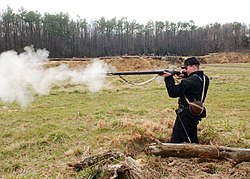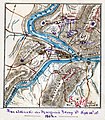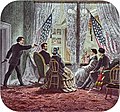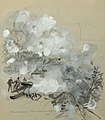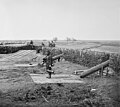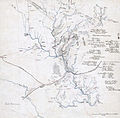 |
 |
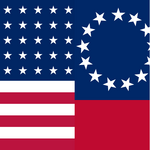
The American Civil War (1861–1865) was a sectional rebellion against the United States of America by the Confederate States, formed of eleven southern states' governments which moved to secede from the Union after the 1860 election of Abraham Lincoln as President of the United States. The Union's victory was eventually achieved by leveraging advantages in population, manufacturing and logistics and through a strategic naval blockade denying the Confederacy access to the world's markets.
In many ways, the conflict's central issues – the enslavement of African Americans, the role of constitutional federal government, and the rights of states – are still not completely resolved. Not surprisingly, the Confederate army's surrender at Appomattox on April 9,1865 did little to change many Americans' attitudes toward the potential powers of central government. The passage of the Thirteenth, Fourteenth and Fifteenth amendments to the Constitution in the years immediately following the war did not change the racial prejudice prevalent among Americans of the day; and the process of Reconstruction did not heal the deeply personal wounds inflicted by four brutal years of war and more than 970,000 casualties – 3 percent of the population, including approximately 560,000 deaths. As a result, controversies affected by the war's unresolved social, political, economic and racial tensions continue to shape contemporary American thought. The causes of the war, the reasons for the outcome, and even the name of the war itself are subjects of much discussion even today. (Full article)
Fort Greble was an American Civil War-era Union fortification constructed as part of the defenses of Washington, D.C. during that war. Named for First Lieutenant John Trout Greble, the first West Point graduate killed in the U.S. Civil War, it protected the junction of the Anacostia and Potomac rivers, and from its position on a bluff in the Congress Heights, precluded any bombardment of the Washington Navy Yard and southeastern portions of the city. It was supported by Fort Carroll to the northeast and Fort Foote to the south. It never fired a shot during the war, and after a brief stint as a U.S. Army Signal Corps training facility, was abandoned and the land returned to its natural state. As of July 2007, the site of the fort is a community park. (Full article...)
During the American Civil War, Missouri was a hotly contested border state populated by both Union and Confederate sympathizers. It sent armies, generals, and supplies to both sides, maintained dual governments, and endured a bloody neighbor-against-neighbor intrastate war within the larger national war.
A slave state since statehood in 1821, Missouri's geographic position in the central region of the country and at the rural edge of the American frontier ensured that it remained a divisive battleground for competing Northern and Southern ideologies in the years preceding the war. When the war began in 1861, it became clear that control of the Mississippi River and the burgeoning economic hub of St. Louis would make Missouri a strategic territory in the Trans-Mississippi Theater. (Full article...)
Thomas Carmichael Hindman Jr. (January 28, 1828 – September 28, 1868) was an American lawyer, politician, and a senior officer of the Confederate States Army during the American Civil War. Born in Knoxville, Tennessee, he later moved to Mississippi and became involved in politics. He served in the Mexican–American War from 1846 to 1848. Hindman practiced law and in 1853 was elected to the Mississippi House of Representatives. After his term expired in 1854, he moved to Helena, Arkansas where there were more opportunities for his political ambitions. Hindman opposed the Know-Nothing party and the ruling Conway-Johnson dynasty. Elected to the United States House of Representatives in 1858, he supported slavery (and was a slaveholder himself) and secession. During Reconstruction he was assassinated.
Once the American Civil War began in 1861 and Arkansas seceded, Hindman joined the Confederate States Army, first commanding the 2nd Arkansas Infantry Regiment, then a brigade, and then an ad-hoc division at the Battle of Shiloh in April 1862; he was wounded during the battle. Following Shiloh, Hindman was promoted to major general and sent to the Trans-Mississippi Department to command Arkansas, Missouri, the Indian Territory, and part of Louisiana. As commander of the region, Hindman's policies were sometimes legally questionable and were unpopular, although they were successful in building up the district from a basically indefensible state. Public outcry led to Hindman's removal from his regional command. He was defeated at the Battle of Prairie Grove in December. Transferred to the Army of Tennessee in 1863, he led a division at the Battle of Chickamauga in September, where he was again wounded. After recovering, he commanded a division during the early stages of the Atlanta campaign although he wished to be transferred elsewhere. (Full article...)
- ... that singer Frank Croxton performed a duet with his father for the unveiling of a monument to a Confederate States Army general?
- ... that Enoch Marvin Banks resigned from the University of Florida because of public outrage over his belief that the American Civil War was caused by slavery?
- ... that CSS Beaufort fought USS Albatross in the first ship-versus-ship action of the American Civil War?
- ... that after the Little Rock campaign, Union forces held three-quarters of Arkansas?
- ... that Romeo and Juliet both served in the Union Navy?
- ... that some historians believe that Steele's Greenville expedition marked a shift in the Union's war policy?
- Attention needed
- ...to referencing and citation • ...to coverage and accuracy • ...to structure • ...to grammar • ...to supporting materials
- Popular pages
- Full list
- Cleanup needed
- The West Tennessee Raids
- Requested articles
- James Ashby (soldier) • Bluffton expedition • Benjamin D. Fearing • Charles A. Hickman • Richard Henry Jackson • James B. Speers • Charles S. Steedman • Battle of Barton's Station • Lawrence P. Graham • Thomas John Lucas • Daniel Henry Rucker • James Hughes Stokes • Frederick S. Sturmbaugh • Davis Tillson • Action at Nineveh (currently a redirect) • International response to the American Civil War • Spain and the American Civil War • Savannah Campaign Confederate order of battle • Native Americans in the American Civil War (currently disambiguation after deletion) • 1st Battalion, Mississippi Mounted Rifles (Union) • Battle of Lafayette • Requested American Civil War Medal of Honor recipients
- Expansion needed
- Battle of Boonsborough • Battle of Guard Hill • Battle of Rice's Station • Battle of Simmon's Bluff • Battle of Summit Point • Charleston Arsenal • Edenton Bell Battery • First Battle of Dalton • Blackshear Prison • Edwin Forbes • Hiram B. Granbury • Henry Thomas Harrison • Louis Hébert (colonel) • Benjamin G. Humphreys • Maynard Carbine • Hezekiah G. Spruill • Smith carbine • Edward C. Walthall • Confederate States Secretary of the Navy • Confederate States Secretary of the Treasury • David Henry Williams • Battle of Rome Cross Roads • Delaware in the American Civil War • Ironclad Board • United States Military Railroad • Kansas in the American Civil War • Rufus Daggett • Ebenezer Magoffin • Confederate Quartermaster-General's Department • First Corps, Army of Northern Virginia • Francis Laurens Vinton • Henry Maury • Smith's Expedition to Tupelo • Other American Civil War battle stubs • Other American Civil War stubs
- Images needed
- Battle of Lone Jack • Preston Pond, Jr. • Melancthon Smith
- Merging needed
- 1st Regiment New York Mounted Rifles and 7th Regiment New York Volunteer Cavalry
- Citations needed
- 1st Alabama Cavalry Regiment (Union) • 4th Maine Battery • 33rd Ohio Infantry • 110th New York Volunteer Infantry • Battle of Hatcher's Run • Camp Dennison • Confederate colonies • CSS Resolute • Dakota War of 1862 • Florida in the American Civil War • Ethan A. Hitchcock (general) • Fort Harker (Alabama) • Gettysburg (1993 film) • Iowa in the American Civil War • Second Battle of Fort Sumter • Samuel Benton
- Translation needed
- Add an article here!
The following Wikimedia Foundation sister projects provide more on this subject:
-
Commons
Free media repository -
Wikibooks
Free textbooks and manuals -
Wikidata
Free knowledge base -
Wikinews
Free-content news -
Wikiquote
Collection of quotations -
Wikisource
Free-content library -
Wikiversity
Free learning tools -
Wikivoyage
Free travel guide -
Wiktionary
Dictionary and thesaurus
- Shortcuts to this page: Portal:ACW • P:ACW
